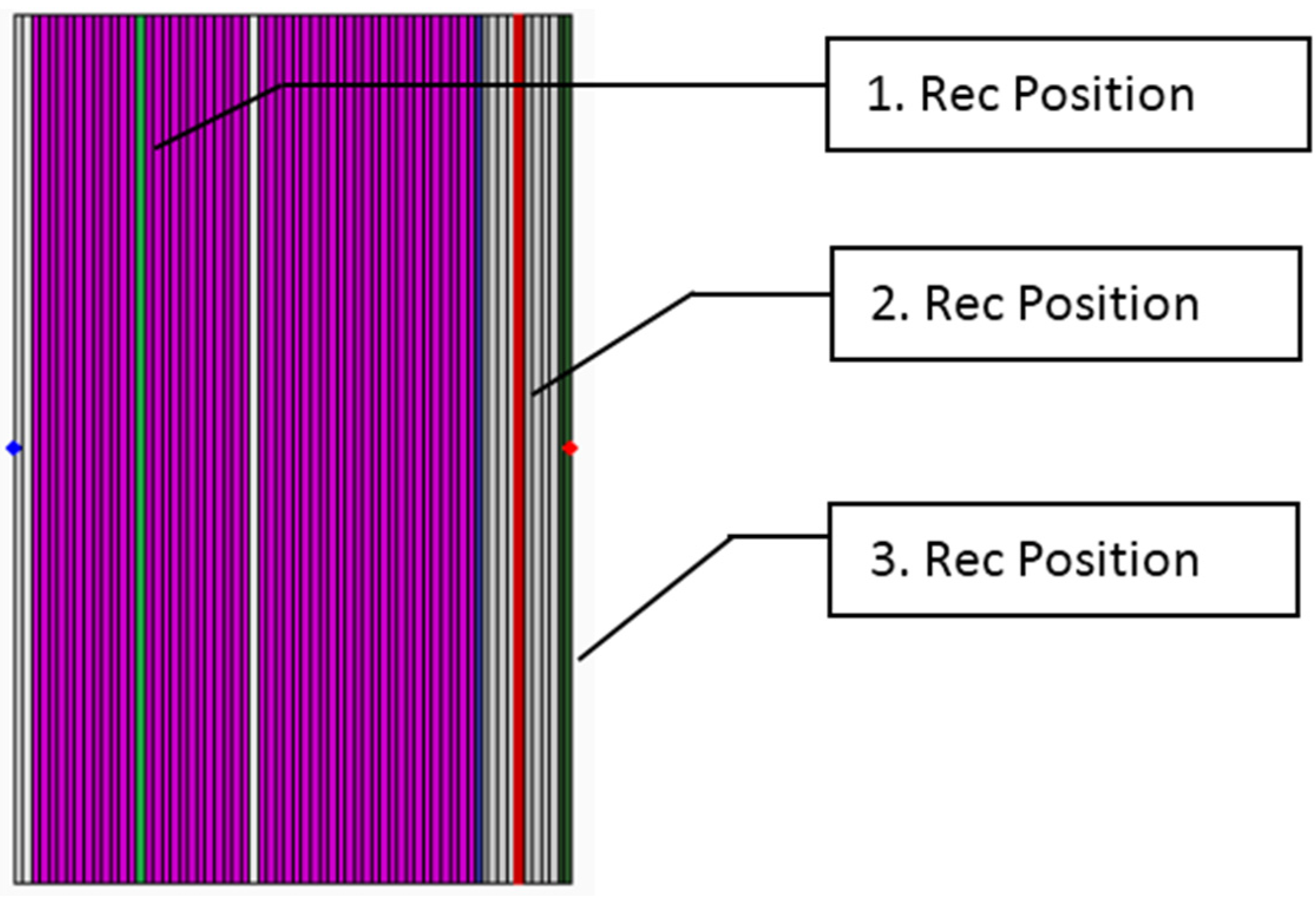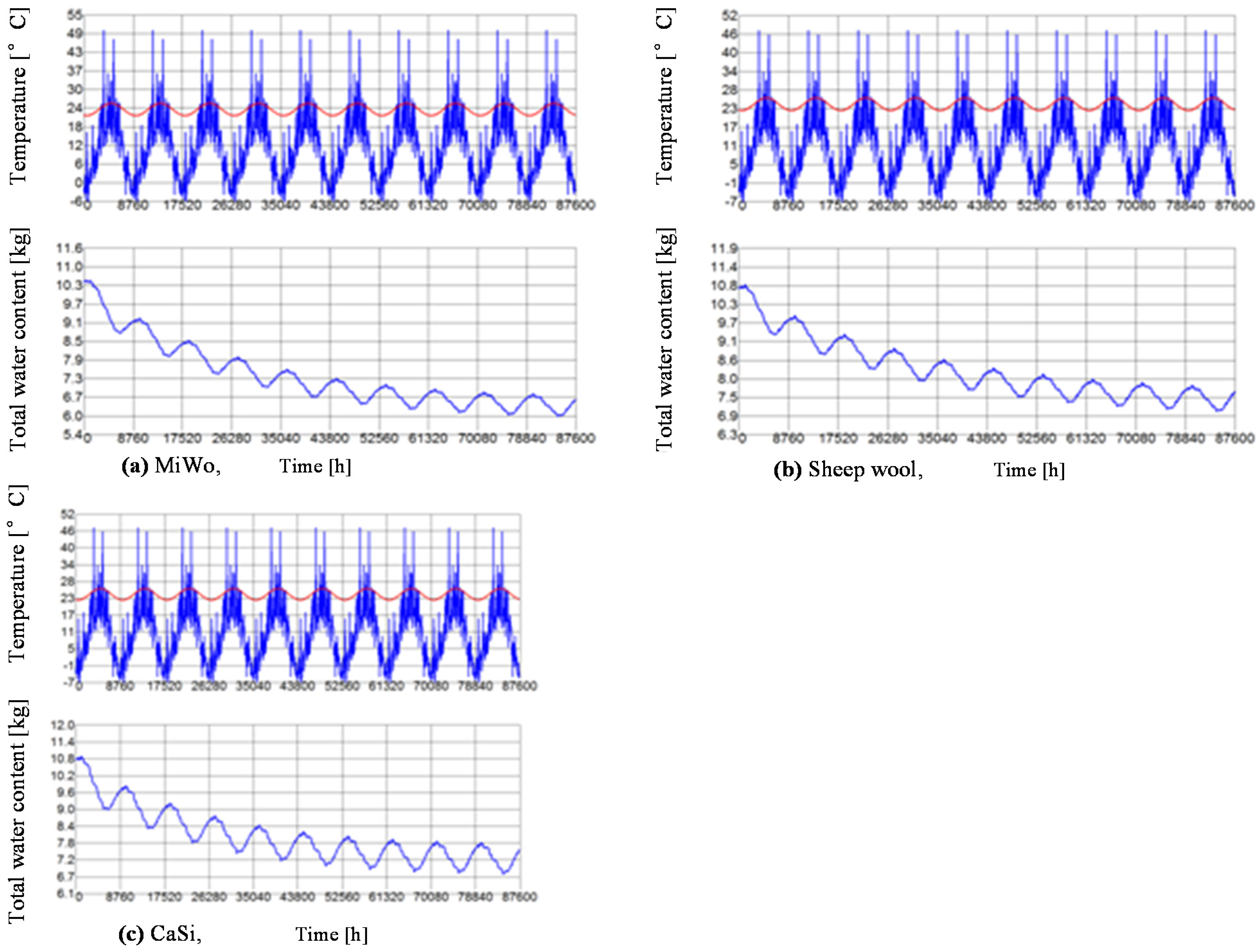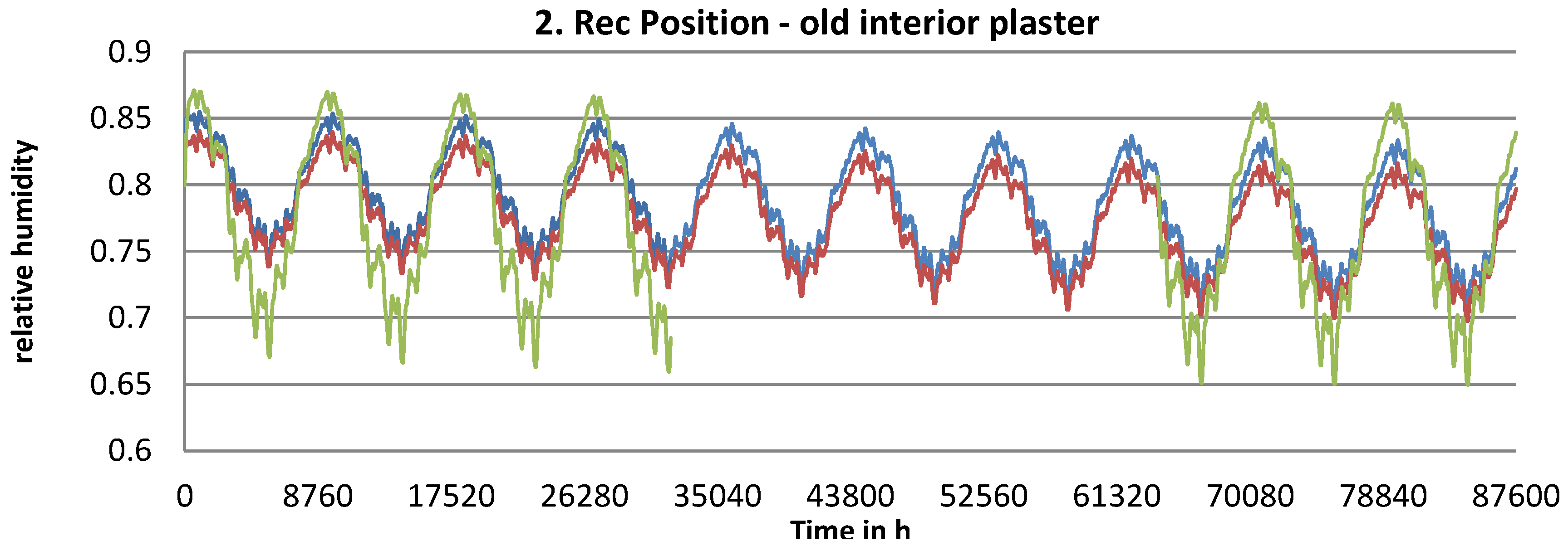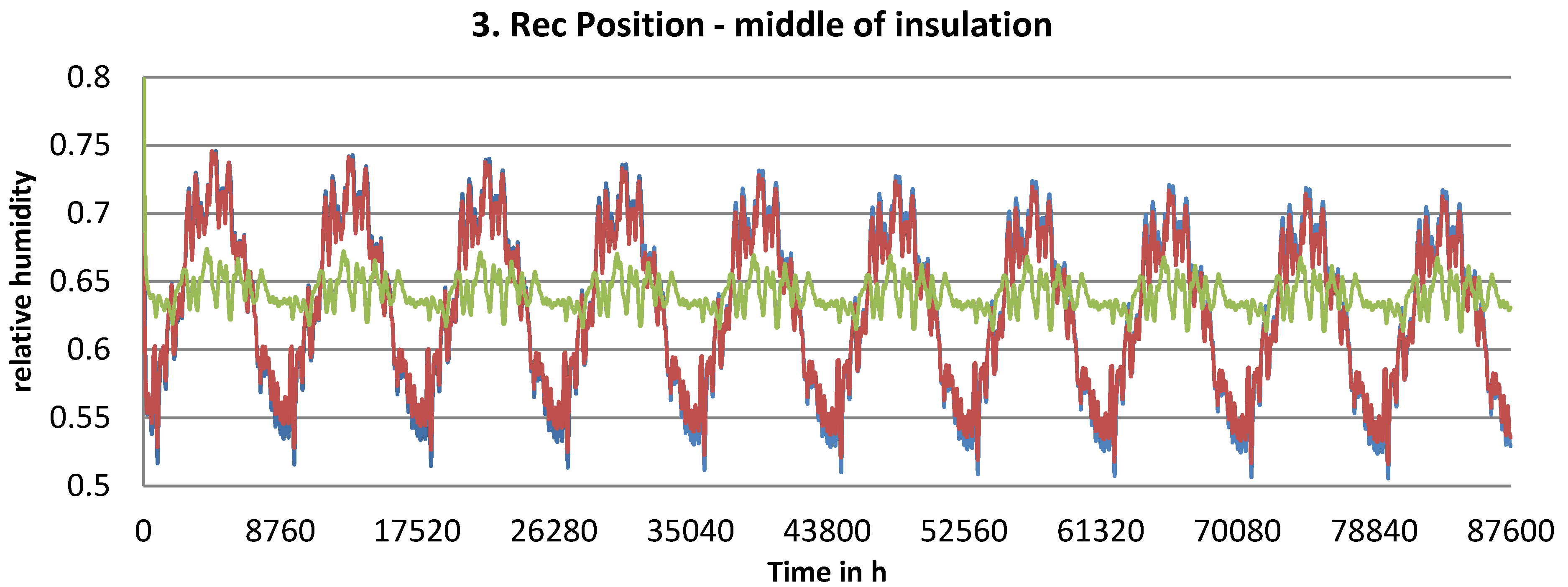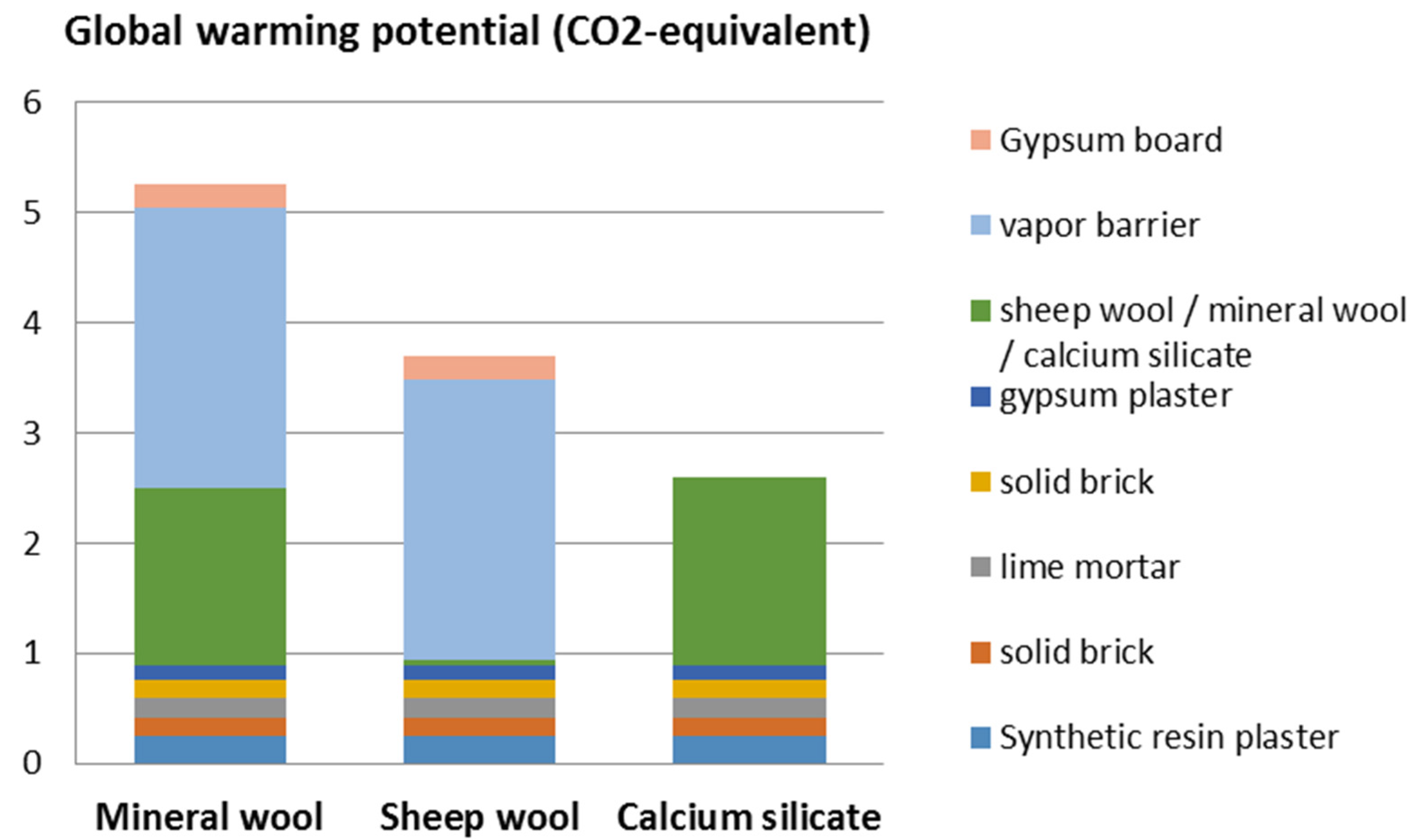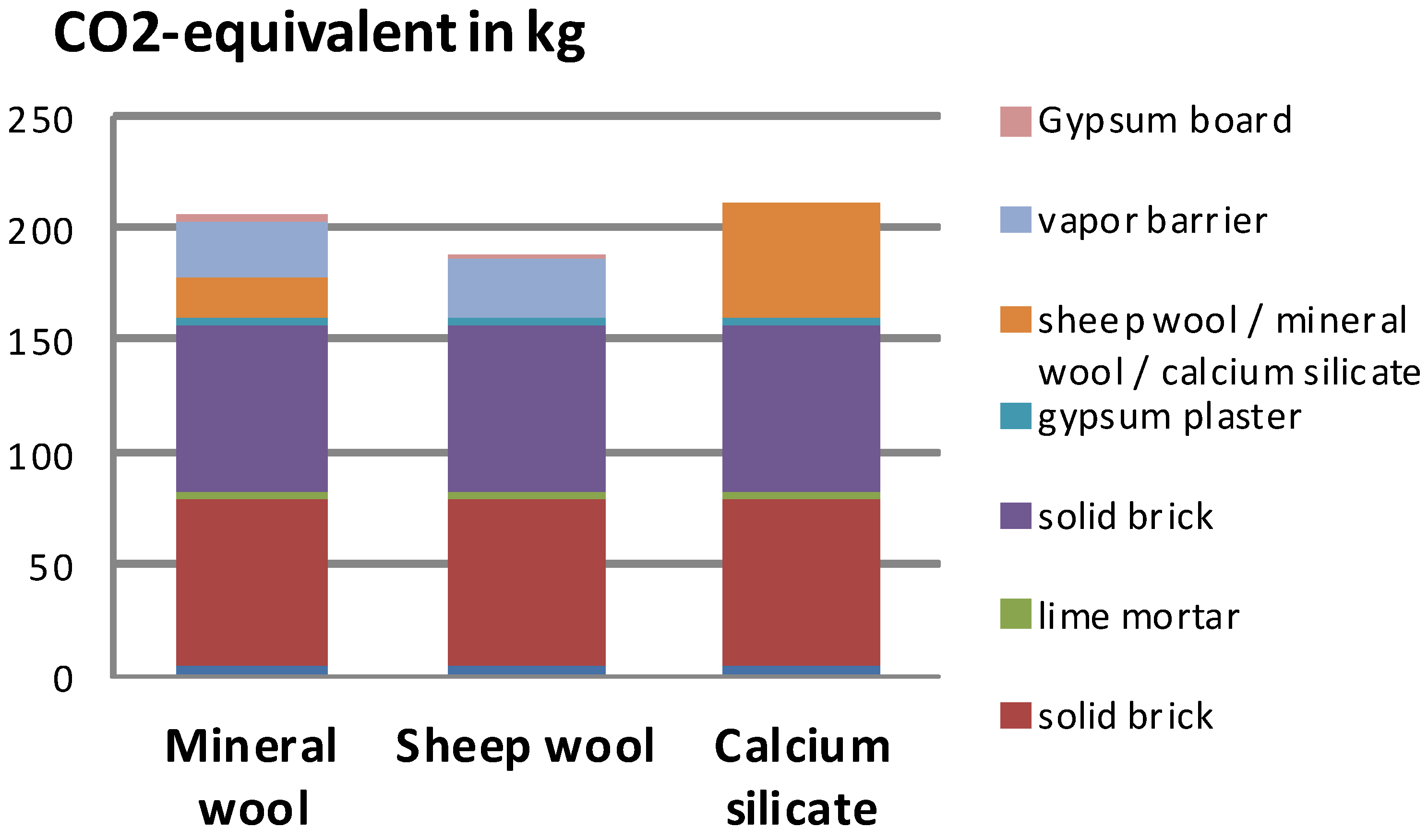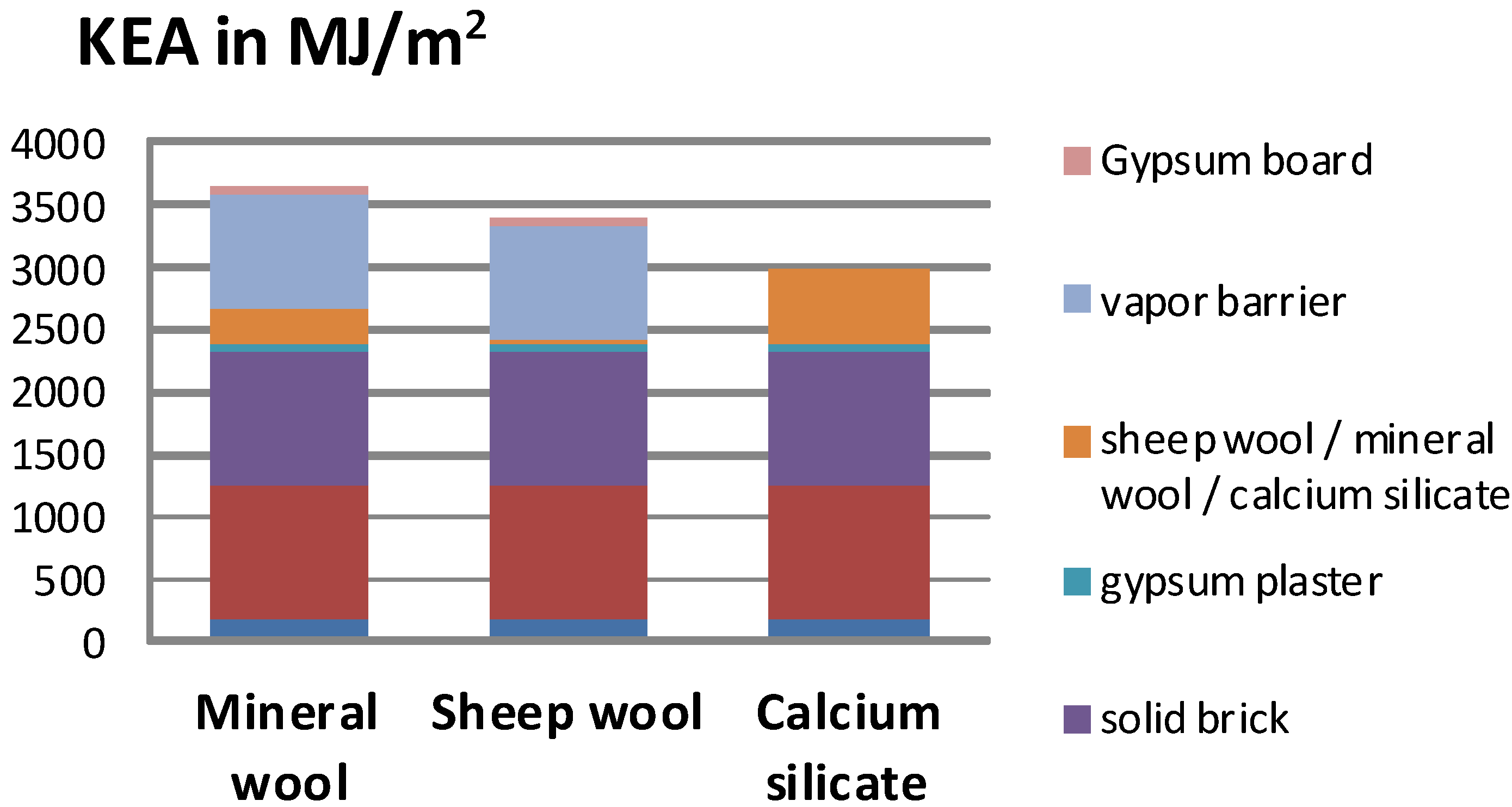1. Introduction
The design of environmentally friendly buildings is currently one of the more compelling issues. The basic premise for eco-design is that human health depends on the quality of air and water as well as on the quality of soil from which foodstuffs are produced. In order to address the misunderstanding as to what constitutes eco-design, it is important to highlight that green design is not just about low-energy consumption, but also about environmental integration through smart design.
The new approaches to energy-efficient and sustainable building designs not only focus on goals to decrease energy consumption, but also to lower construction costs through the application of natural and locally available materials. Environmental awareness consists of energy savings as well as ecologically sound construction, and the materials and methods used throughout all the stages of the life cycle of a building. In this regard, minimum energy input, sustainable resource consumption and minimized pollution should be a part of the production, installation and use of insulation materials [
1]. The Directive 2010/31/EU of the European Parliament and the European Council (dated 19 May 2010) on the energy performance of buildings require that “the energy performance certificate should also provide information about the actual impact of heating and cooling on the energy needs of the building, on its primary energy consumption and on its carbon dioxide emissions” [
2].
Therefore, from the perspective of sustainable development it is important to choose easily recyclable, renewable, locally available and environmentally friendly raw materials, such as timber, clay, stone, straw, bio-based fibers and sheep wool, provided that any further processing is carried out with low energy consumption. The rapidly rising fears that raw materials and energy resources would eventually be depleted, in addition to the concerns regarding excessive air pollution are encouraging scientific and cross-disciplinary engagement on this topic. There are fundamental differences between the engineering and the ecological approaches to green or eco-design. In the engineering approach, the designer begins with the final picture of the desired outcome governed by the process of efficiency that culminates in production. In contrast, the ecological design approach begins with environmental discernment (seeing what there is) and is governed by the process of achieving environmental harmony.
In both aforementioned approaches, and more emphasis ought to be placed on the non-toxic materials, transformability and recyclability. In addition to energy, demanding technologies are shifted towards organic materials—the natural raw materials that meet the majority of requirements for alternative resource, sustainable development and innovative green technologies. Recent investigations were carried out with natural materials, indicating that they are comparable with standard building materials.
The demand for green building materials, especially insulating materials from renewable resources, is sharply rising [
3]. Sheep wool as a natural material has been traditionally used in the textile industry for the manufacture of conventional woolen products, such as carpets, garments, curtains, covers and bedding. Even though sheep wool insulation is a relatively well developed marked in Western Europe, most of the elements made from sheep wool in Bosnia and Herzegovina (BiH) building sector have been exclusively used for interior decoration purposes.
The application of natural materials from renewable resources with comparable physical and mechanical properties to conventional materials has become more important. With respect to recent developments in science and technology, it is safe to say that thermal insulators made from natural materials are likely to become a suitable alternative to commonly used boards made from different man-made materials (mineral wool, polystyrene or polyurethane). The properties of insulating boards made of organic fibres are fully comparable with common insulating boards made from other materials [
4]. The use of natural materials in buildings is beneficial to human health [
5]. Expanded polystyrene (EPS) is one of the most common materials used as thermal insulation in buildings today, and its use has been connected with serious safety, environmental and health concerns as it has extremely high flammability and produces toxic fumes [
6].
The Life Cycle Assessment (LCA) approach has become a common tool for the assessment of prime energy and CO
2 emissions. The comparison of primary energy need and CO
2 emission between 1 m
3 of sheep wool insulation and mineral wool demonstrates that the former produces almost 5.4 kg of CO
2, whereas the CO
2 yield of the latter is 135 kg [
7]. With the growing demand for affordable housing and the importance of supporting and stimulating sustainable development, the need for sustainable solutions and clean technologies in this sector is essential for strategic development of less-developed countries. Traditional technologies need to be developed with the aim of achieving more standardized and flexible solutions within the framework of sustainable business models. On the other hand, the environmental and socio-economic performance of the more industrial solutions needs to be improved while maintaining their competitive presence in the market [
8]. This research reveals that traditional textile industry technologies and methods used for wool processing, which prove to be far less detrimental to the environment, could be a sustainable answer for insulation panel manufacture and thereby suggest new possibilities in the building industry. Test results with sheep wool indicate the material’s excellent performance in the development of building thermal insulation elements.
3. Building Physical Examination: Comparison of Three Insulation Materials
The energy renovation of buildings is currently a high-priority topic, not only in Europe but all over the world. For standard energy renovation, synthetic insulation materials, such as EPS, are used. To meet the European Union requirements and to allow sustainable architecture, new solutions with natural building materials are necessary.
This part presents examinations of insulating wall constructions with various thermal insulation materials as well as a comparison between sheep wool, mineral wool and calcium silicate insulation. A refurbishment of an external wall with internal insulation was investigated and a comparison of different insulation materials was made. Building-physics assessment was conducted regarding the U-value using statistics and Hygrothermal Simulation programs. In addition, ecological balance studies where carried out.
Figure 1.
The structure of a common existing wall that was renovated using an interior insulation: (a) with wool insulation; (b) with calcium silicate board.
Figure 1.
The structure of a common existing wall that was renovated using an interior insulation: (a) with wool insulation; (b) with calcium silicate board.
Figure 1 illustrates the structure of a common existing wall. The building physics Heat, Air and Moisture simulation program (HAM 3D), developed at the Vienna University of Technology, was used for hygrothermal investigation. The program solves numerical equations for the coupled heat, moisture and air transport in porous building materials, given the boundary conditions such as weather, location and materials data.
Table 2.
Internal insulation with mineral wool. External wall refurbishment with 8 cm of mineral wool, internal insulation.
Table 2.
Internal insulation with mineral wool. External wall refurbishment with 8 cm of mineral wool, internal insulation.
| Materials | d | λ | μ | Rsi+Rse |
|---|
| [m] | [W/mK] | [–] | [m2K/W] |
|---|
| Air (i und e) | – | – | – | 0.17 |
| Synthetic resin plaster | 0.02 | 0.7 | 50 | – |
| Solid brick | 0.25 | 0.55 | 7 | – |
| Lime mortar | 0.01 | 0.2 | 10 | – |
| Solid brick | 0.25 | 0.55 | 7 | – |
| Gypsum plaster | 0.015 | 0.2 | 10 | – |
| Mineral wool | 0.08 | 0.038 | 1 | – |
| Vapour barrier (PE foil) | 0.01 | 0.23 | 100,000 | – |
| Gypsum plasterboard | 0.015 | 0.2 | 1 | – |
| U-Value | 0.29 | W/m2K | | |
Table 3.
Internal insulation with sheep wool. External wall renovation with 8 cm sheep wool, internal insulation.
Table 3.
Internal insulation with sheep wool. External wall renovation with 8 cm sheep wool, internal insulation.
| Materials | d | λ | μ | Rsi+Rse |
|---|
| [m] | [W/mK] | [–] | [m2K/W] |
|---|
| Air (i und e) | – | – | – | 0.17 |
| Synthetic resin plaster | 0.02 | 0.7 | 50 | – |
| Solid brick | 0.25 | 0.55 | 7 | – |
| Lime mortar | 0.01 | 0.2 | 10 | – |
| Solid brick | 0.25 | 0.55 | 7 | – |
| Gypsum plaster | 0.015 | 0.2 | | – |
| Sheep wool | 0.08 | 0.04 | 1 | – |
| Vapour barrier (PE foil) | 0.01 | 0.23 | 100,000 | – |
| Gypsum plasterboard | 0.015 | 0.2 | 1 | – |
| U-Value | 0.30 | W/m2K | | |
Table 4.
Internal insulation with calcium silicate board. External wall renovation with 10 cm calcium silicate board, interior insulation.
Table 4.
Internal insulation with calcium silicate board. External wall renovation with 10 cm calcium silicate board, interior insulation.
| Materials | d | λ | μ | Rsi+Rse |
|---|
| [m] | [W/mK] | [–] | [m2K/W] |
|---|
| Air (i und e) | – | – | – | 0.17 |
| Synthetic resin plaster | 0.02 | 0.7 | 50 | – |
| Solid brick | 0.25 | 0.55 | 7 | – |
| Lime mortar | 0.01 | 0.2 | 10 | – |
| Solid brick | 0.25 | 0.55 | 7 | – |
| Gypsum plaster | 0.015 | 0.2 | – | – |
| Calcium silicate board | 0.1 | 0.07 | 10 | |
| U-Value | 0.38 | W/m2K | | |
The HAM 3D program delivers component information such as temperature course, moisture content, partial pressure, relative humidity, capillary pressure, condensate, air flow and the locations of the potential growth of mould and mildew and any other form of decay.
Building physics simulations of the wall using different insulation materials were carried out in which moisture content and dynamic U-value were examined. U-values calculations of these three variants are presented in
Table 2,
Table 3 and
Table 4. In the calculations with the HAM 3D program, the building components have been cut into 1 cm thick layers (fine grid,
Figure 2).
Figure 2.
The recorder positions.
Figure 2.
The recorder positions.
Three recorder positions—from which the data were supposed to be analyzed in detail—were placed in the same locations as indicated to ensure a better comparison:
Recorder position 1: external solid brick—centre;
Recorder position 2: old interior plaster;
Recorder position 3: MiWo/sheep wool/CaSi—centre.
Boundary conditions used for the simulation were as follows: Vienna hourly weather data without rain; absorption coefficient of 0.8; indoor relative humidity of 40%; Sky-factor of 0.5. The evaluation of the simulation is performed with four diagrams: Temperature course; Total water content of the construction; Relative humidity in the old interior plaster (Recorder position 2); Relative humidity in the centre of the insulation (Recorder position 3).
Furthermore, the potential for mould growth is presented. The assessment from the HAM 3D is based on studies by Viitanen [
12]. The thermal and moisture behaviour of building materials, and subsequently the building envelope, is a significant aspect of the whole building performance [
13].
The HAM 3D simulation was carried out for ten years, so that the tendency of the moisture content due to the diffusion can be clearly seen (
Figure 3). The red line presents the temperature course.
The total water content is a bit larger in buildings containing wool as compared to other materials. This observation is attributed to wool’s moisture absorption characteristic. In both variants, the total water content decreased with time. Relative humidity is a key factor in the mould growth, and the risk of its growth usually starts at 80% relative humidity for a longer duration of time. Diagrams in
Figure 4 and
Figure 5 illustrate the variations of the relative humidity in the three investigated variants at two different recorder positions. The openness of the calcium silicate plate allows diffusion of more moisture into the old interior plaster than with the other two variants, and this moisture could be completely dried out.
Figure 3.
Temperature: exterior (blue), interior (red) and total water content (a) MiWo; (b) Sheep wool and (c) CaSi.
Figure 3.
Temperature: exterior (blue), interior (red) and total water content (a) MiWo; (b) Sheep wool and (c) CaSi.
Figure 4.
Relative humidity at Rec Position 2, in old interior plaster; (blue) MiWo, (red) Sheep wool and (green) CaSi.
Figure 4.
Relative humidity at Rec Position 2, in old interior plaster; (blue) MiWo, (red) Sheep wool and (green) CaSi.
The third recorder position shows that for all three variants, the relative humidity in the middle of the insulation layer remains below 80%, and this results in a minimal to no risk of mould formation. Calcium silicate revealed the least moisture content. In the case of an interior insulation, the potential of mould growth is a very important criterion. The mould growth potential [
12] was also simulated using the HAM 3D program. In all three variants, the probability of mould growth in the interior side of old plaster (cold side of the insulation) was found to be the highest.
Figure 5.
Relative humidity at Rec Position 3, in the middle of insulation; (blue) MiWo, (red) Sheep wool and (green) CaSi.
Figure 5.
Relative humidity at Rec Position 3, in the middle of insulation; (blue) MiWo, (red) Sheep wool and (green) CaSi.
The calcium silicate board takes up a lot of humidity from the room air and therefore accumulates significant amounts of water on the cold side of the insulation board. However, this could to be released back. Sheep wool also has good absorption/desorption properties, and therefore its risk of mould growth is lower than that for mineral wool. The moisture content in the buildings increases through diffusion. It increases the thermal conductivity of the material, and thereby increases the heat flow and consequently the U-value of the buildings. In fact, at existing conditions, the effect is amplified. All of these attributes result in the smallest U-value in the winter time. The change in the U-value over the course of one year is smaller in a building whose constriction encompasses sheep wool (
Table 5). Due to this stable hygrothermal situation is the construction more protected of hygrothermal expansion and contraction, and thereby, the entire component is mechanically less stressed. The average U-value is marginally larger.
Table 5.
Impact of seasonal moisture content variations on of the change of U-values (W/m2K).
Table 5.
Impact of seasonal moisture content variations on of the change of U-values (W/m2K).
| Material | Maximum | Minimum | Average |
|---|
| Mineral wool | 0.38 | 0.2 | 0.29 |
| Sheep wool | 0.33 | 0.29 | 0.31 |
| Calcium silicate | 0.41 | 0.36 | 0.385 |
Based on the calculation results, it can be stated that thermal insulation made from sheep wool provides comparable characteristics to those made from conventional materials and in some applications, it even performs better. Sheep wool is mainly characterized by high hygroscopicity, which is a material’s ability to absorb moisture, and materials with this characteristic also adjust air humidity and hence create a pleasant indoor climate. It has been previously shown that in a component that has up to 20% moisture content, the weight increase due to this moisture content does not change the thermal conductivity coefficient significantly [
4].
The sheep wool as an interior insulation with vapour barrier, is an optimal solution for building physics because of its absorption characteristic and ability to keep the absorbed moisture as well as eventually release it again. It still accumulates moisture on the cold side of the insulation, but less so than insulation made up of the mineral wool. Therefore, the use of sheep wool in combination with other renewable resources appears to be the best alternative to reduce the primary energy requirements of a building and thereby meet the energy efficiency and sustainability requirements.
4. Ecological Balance
Based on the data from [
1,
7,
8], the three investigated variants were previously compared with regard to their environmental performances in manufacturing, transportation, usage, recycling and release of greenhouse gases (e.g., CO
2, CH
4) The global warming potential is a variable that describes a material’s impact on the environment over the course of 100 years in reference to CO
2. The diagram in
Figure 6 clearly indicates that sheep wool has a low global warming potential. The variant with calcium silicate requires no vapour barrier and no gypsum board thus the overall design has a smaller CO
2-equivalent balance.
Figure 6.
Global warming potential of the constructions with mineral wool, sheep wool and calcium silicate.
Figure 6.
Global warming potential of the constructions with mineral wool, sheep wool and calcium silicate.
A more relevant picture with respect to the negative emission illustrates the global warming potential in relation to the built-in building material compositions. According to the observations, the smallest amount of CO
2 emitted from the construction belongs to sheep wool (
Figure 7).
One of the most important parameters in the ecological balance is the cumulated energy demand (KEA = CED) that indicates how much energy a building material or a construction in its life cycle, indirectly or directly, consumes (
Figure 8). The CED values of materials are expressed in MJ/m
3, which was converted to MJ/m
2 to make the energy consumption values comparable.
The smallest energy consumption value belongs to calcium silicate board as no vapour barrier is necessary. However, considering only the insulation itself, the sheep wool is the most energy efficient material in this application.
Figure 7.
CO2 equivalent in kg of the constructions with mineral wool, sheep wool and calcium silicate.
Figure 7.
CO2 equivalent in kg of the constructions with mineral wool, sheep wool and calcium silicate.
Figure 8.
Cumulative energy demand of the constructions with mineral wool, sheep wool and calcium silicate.
Figure 8.
Cumulative energy demand of the constructions with mineral wool, sheep wool and calcium silicate.
7. Conclusions and Outlook
Sheep wool is a natural, renewable and sustainable material, and it is important to ensure that it is used in an environmentally friendly manner. The future well-organized collection and clean production of sheep wool insulation could create a positive effect on the Bosnia and Herzegovina (BiH) and regional socio-economical development through the creation of a suitable environment for farmers, SMEs, local communities. All of the aforementioned could result in enhanced standard and quality of life in rural areas. This study was focused on the alternative uses of wool as a construction material beyond its traditional uses in the textile industry. This research shows that sheep wool could be used as a very good natural resource in the building industry for insulation in BiH and the surrounding countries.
Local natural materials, such as sheep wool, provide sustainable answers for all requirements of contemporary architecture as appropriate materials for insulation and energy saving in buildings. Based on the results of this study, it can be concluded that thermal insulation from sheep wool provides comparable characteristics with convectional materials, and in some applications, even performs better.
Environmental strategy defines aims in terms of the concept of sustainable production and consumption. All products experience environmental degradation through their life cycle. On one hand, there is the consumption of raw materials and energy, while on the other hand, there is the emergence of adverse outputs in the form of waste and emissions. A quick LCC study revealed that, on most levels, the production and further manufacturing of sheep wool insulation panels ranks high in positive environmental impact. However, it is important that standardized and sustainable procedures are thoroughly followed through all the stages.
This research disclosed many opportunities for future scientific approaches to other possible investigation of the use of natural materials as means to produce high performance thermal insulation. Taking into consideration that BiH and the surrounding countries do not have a strategic plan in place for the use of this growing material, this investigation could serve as a potential starting point for positive changes that would lead to a balanced socio economic development. Ultimately, it opened the horizon for new and extensive research as well as to looking at other possible combinations of the sheep wool with local natural materials, such as clay, lime, straw, and other non-traditional usage of sheep wool in clean sustainable architecture and other sectors.

